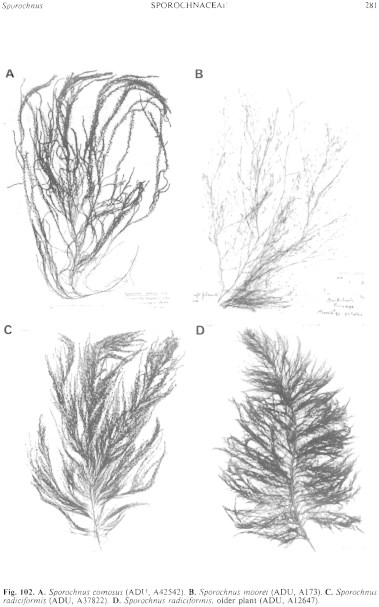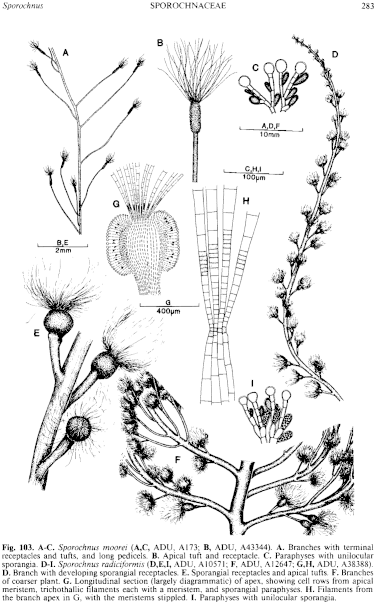|
|
|
|
|
|||||||||||
|
Electronic Flora of South Australia Species Fact Sheet
Phylum Phaeophyta – Order Sporochnales
Selected citations: Harvey 1862: pl. 225. Womersley 1967: 241.
Synonyms
Fucus radiciformis Turner 1811: 128, pl. 189.
Sporochnus scoparius Harvey 1855: 535; 1862, pl. 226. Womersley 1967: 241. S. cryptocephalus Kützing 1859: 35, pl. 85 fig. II.
S. obovatus Kützing 1859: 34, pl. 83 fig. II.
S. sphaerocephalus Kützing 1859: 34, pl. 83 fig. I.
Thallus (Fig. 102C,D) medium brown, (10–) 20–90 cm long, usually pyramidal in form with one (to several) main, percurrent axis bearing numerous long, radially arranged, laterals (Fig. 103D,F) progressively decreasing in length towards the apex, each lateral similarly branched to 4 or 5 orders, each ultimate branchlet with an apical tuft of assimilatory filaments which is usually lost from older parts; holdfast rhizoidal, 2–15 (–20) mm across and 4–15 mm long, with older main axes becoming stupose; epilithic. Growth (Fig. 103G) apical, with a convex branch meristem surmounted by the tuft of trichothallic filaments 1–4 (–6) mm long, each with a meristem (Fig. 103G,H) 5–8 cells above their base, 12–25 (–40) mm in diameter above with cells L/B 3–8. Fronds slender, becoming robust below (Fig. 103F), (0.5–) 1–2 mm in diameter in lower axes in young plants, increasing to 2–3 mm in older plants by periclinal cortical divisions, 200–300 µm in diameter near the apices, with the branchlets (0.5–) 1–3 mm apart, (0.5–) 1–6 mm long and 60–100 in diameter. Structure haplostichous and pseudo-parenchymatous with a medulla of elongate cells and a single-layered cortex (becoming multilayered in older axes) with cells 6–10 Atm across and L/B (1–) 1.5–2.5.
Reproduction: Sporangial receptacles (Fig. 103E,F) immediately below apical tufts, globular to pyriform or ovoid, becoming clavate in some specimens, (300–) 400–1000 Am(-3 mm) long and (150–) 250–700 µm in diameter, with a sterile pedicel 1–2 (–6) mm long and several times the length of the receptacle. Paraphyses (Fig. 1031) 60–80 µm and 5–6 cells long, simple with the larger terminal cell pyriform to subspherical, (8–) 10–16 µ in diameter, bearing lateral, clavate, unilocular sporangia 20–30 µm long and 6–8 µm in diameter.
Gametophyte unknown.
Type from "New Holl." (Lambert); in BM (ex K).
Selected specimens: "Swan River", W. Aust. (Harvey, Alg. Aust. Exsicc. 53; TCD-type of S. scoparius). Hopetoun, W. Aust., drift (Gordon, 20.xi.1968; ADU, A34128). Pearson I., S. Aust., 30 m deep (Shepherd, 8.i.1969; ADU, A33737). Coffin Bay, S. Aust., 2.5 m deep (Womersley, 4.xii.1975; ADU, A46923). Investigator Str., S. Aust., 31 m deep, 35°21'S, 137°17'E (Watson, 24.i.1971; ADU, A38388). Vivonne Bay, Kangaroo I., S. Aust., drift (Womersley, 14.i.1948; ADU, A6869 and 17.i.1950; ADU, Al2647); and shaded pool, S. side Ellen Point (Womersley, 2.i.1949; ADU, A10571). Nora Creina, S. Aust., reef pools (Womersley, 17.i.1971; ADU, A37822-"Marine Algae of southern Australia" No. 48). Bridgewater Bay, Vic., lower eulittoral pool (Beauglehole, 26.xii.1950; ADU, A15681). Bicheno, Tas., 0–5 m deep (Olsen, 29.xii.1963; ADU, A27073).
Distribution: From Rottnest I., W. Aust. around southern Australia and Tasmania to Botany Bay, N.S.W. (May 1939, p. 197).
Japan?
Taxonomic notes: There is little doubt that S. scoparius is only a larger and older form of S. radiciformis and must be placed in synonymy. Turner's illustration (1811, pl. 189) of the latter is very similar to Harvey's figure (1862, pl. 226) of S. scoparius, both showing almost globular to ovoid sporangial receptacles. Likewise, there are no apparent differences from the types of S. sphaerocephalus Kützing, S. cryptocephalus Kützing and S. obovatus Kützing, as noted by Womersley (1967, p. 241).
Typical S. radiciformis has subspherical to ovoid sporangial receptacles, which develop further with age becoming clavate and 2–3 mm long. While further studies of this variation are needed, it appears that they are only growth or ecological forms of S. radiciformis. Most specimens have trichothallic filaments 12–20 µm in diameter, but some (e.g. ADU, A6869) have such filaments 28–40 µm in diameter. The plants are otherwise very similar and this feature is regarded as variable within the species.
References:
AGARDH, C.A. (1817). Synopsis Algarum Scandinaviae. (Lund.)
HARVEY, W.H. (1862). Phycologia Australica. Vol. 4, Plates 181–240. (Reeve: London.)
KÜTZING, F.T. (1859). Tabulae Phycologicae. Vol. 9. (Nordhausen.)
MAY, V. (1939). A key to the marine algae of New South Wales. Part. II. Melanophyceae (Phaeophyceae). Proc. Linn. Soc. N.S.W. 64, 191–215.
TURNER, D. (1811). Fuci sive Plantarum Fucorum Generi a Botanicis Ascriptarum 'cones Descriptiones et Historia. Vol. 3, pp. 1–148, Plates 135–196. (London.)
WOMERSLEY, H.B.S. (1967). A critical survey of the marine algae of southern Australia. II. Phaeophyta. Aust. J. Bot. 15, 189–270.
The Marine Benthic Flora of Southern Australia Part II complete list of references.
Publication:
Womersley, H.B.S. (14 December, 1987)
The Marine Benthic Flora of Southern Australia
Part II
©Board of the Botanic Gardens and State Herbarium, Government of South Australia
Illustrations in Womersley Part II, 1997: FIGS 102C,D, 103 D–I.

Figure 102 enlarge
Fig. 102. A. Sporochnus comosus (ADU, A42542). B. Sporochnus moorei (ADU, A173). C. Sporochnus radiciformis (ADU, A37822). D. Sporochnus radiciformis, older plant (ADU, A 12647).

Figure 103 enlarge
Fig. 103. A–C. Sporochnus moorei (A,C, ADU, A173; B, ADU, A43344). A. Branches with terminal receptacles and tufts, and long pedicels. B. Apical tuft and receptacle. C. Paraphyses with unilocular sporangia. D–I. Sporochnus radiciformis (D,E,I, ADU, A10571; F, ADU, Al2647; G,H, ADU, A38388). D. Branch with developing sporangial receptacles. E. Sporangial receptacles and apical tufts. F. Branches of coarser plant. G. Longitudinal section (largely diagrammatic) of apex, showing cell rows from apical meristem, trichothallic filaments each with a meristem, and sporangial paraphyses. H. Filaments from the branch apex in G, with the meristems stippled. I. Paraphyses with unilocular sporangia.

|
Email Contact: State Herbarium of South Australia |

|